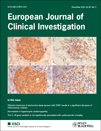Non-obese early onset diabetes mellitus in mutant cryptochrome1 transgenic mice
Abstract
Eur J Clin Invest 2010; 40 (11): 1011–1017
Background An earlier report described that transgenic mice ubiquitously expressing cryptochrome1 (CRY1) with a mutation in cystein414 (CRY1-AP Tg mice) display diabetes mellitus in addition to anomalous circadian behaviours. This study examined characteristic aspects of symptoms to clarify the diabetes type and pathogenesis.
Materials and methods The body weights and blood glucose levels of CRY1-AP Tg mice were measured for 7 weeks starting at 3 weeks after birth. Glucose tolerance test for the mice of various ages and insulin tolerance test at 6 weeks of age were conducted. Immunohistochemical analysis of islets was carried out for the mice of 19 and 40 weeks of age. Basal and glucose-stimulated serum insulin levels of mice at 27 weeks were also measured.
Results Three-week-old CRY1-AP Tg mice, which showed mild retardation in growth, already displayed glucose intolerance. Hyperglycaemia progressed with age, without accompanying insulin resistance. Insulin-stained areas in islets in CRY1-AP Tg mice were smaller than that in wild-type controls. Both basal and glucose-stimulated secretion of insulin decreased in CRY1-AP Tg mice.
Conclusion The symptoms of diabetes in CRY1-AP Tg mice turned out to be similar to those of maturity onset diabetes of the young (MODY) in humans in terms of early onset, non-obesity and primary dysfunction of beta cells. The CRY1-AP Tg mice might serve as an animal model of early onset insulin-secretory defect of diabetes.




